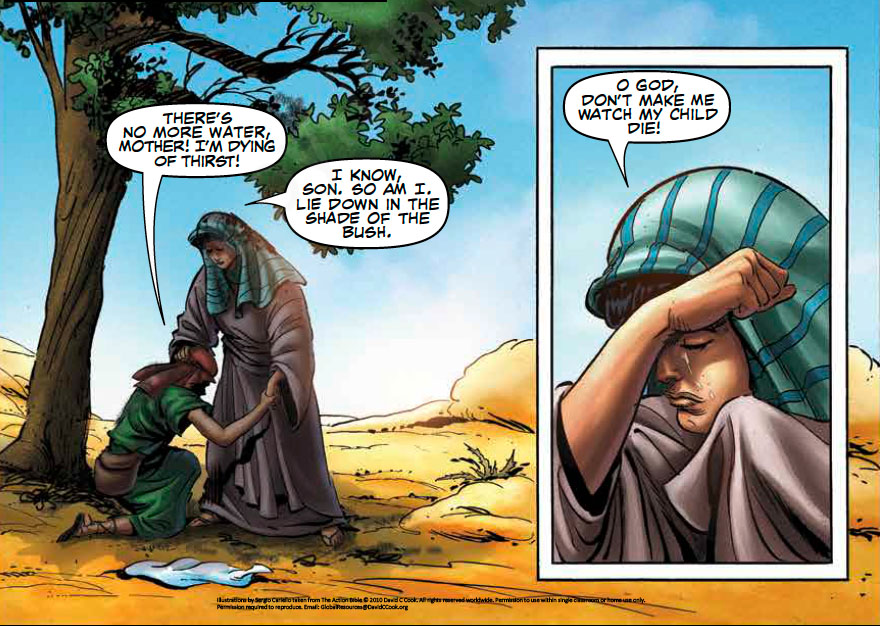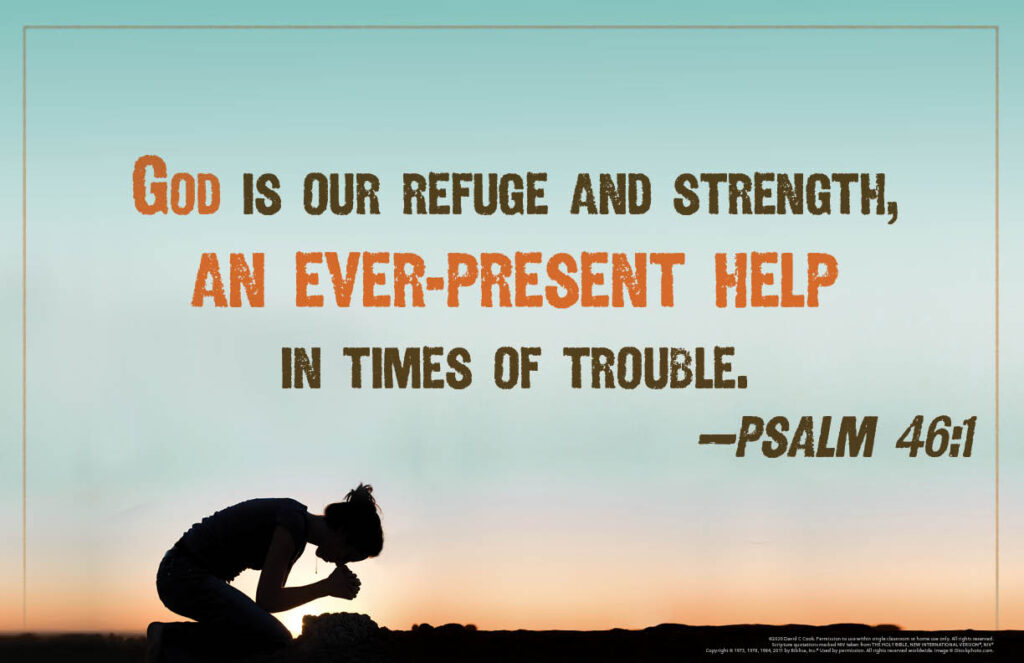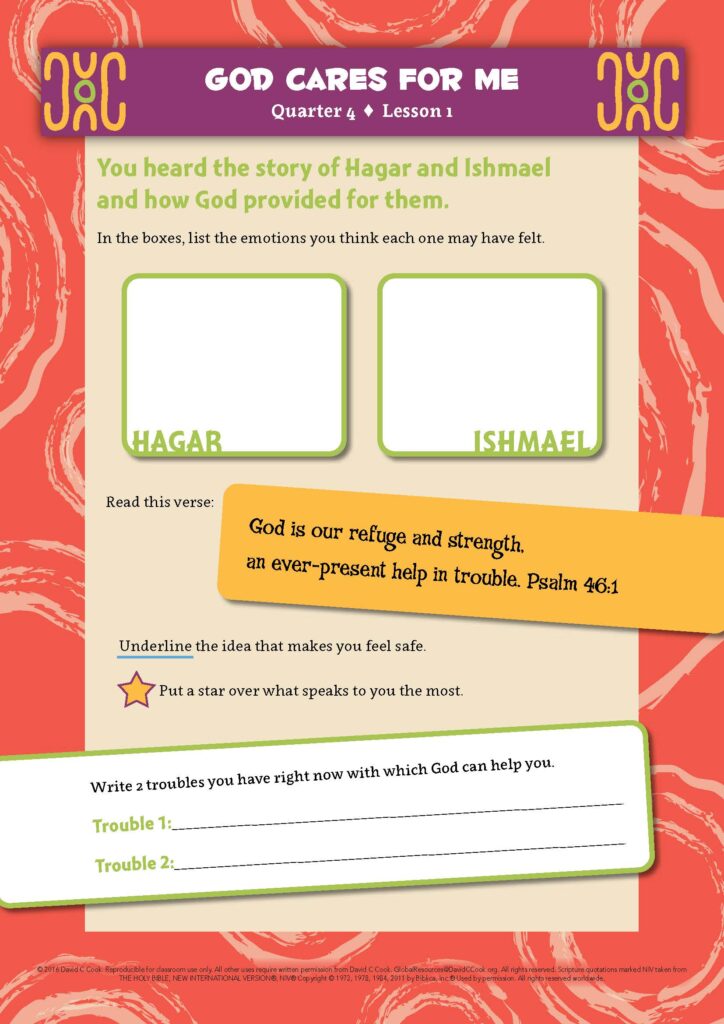During the lesson, the information for you to know is written in regular type, and what we suggest speaking or reading aloud to children is in bold. All resources for this lesson, including the Teacher Guide, Student Page, Family Connection Card, and other resources can be downloaded in a ZIP file by clicking on the following link:
In some lessons you will find "resource articles." These are articles written by experts from around the world to help equip you for your work with children and adolescents. Share them with parents or guardians if you consider it appropriate.
God is our refuge and strength, an ever-present help in trouble.
Psalm 46:1
Hagar was a slave—not in control of her life. She was given to Abram to produce a son. She was abused by Sarai. Then she ran away from those hard circumstances. Out in the desert, desperate and alone, she encountered God—the One who sees her.
He knew Hagar’s name. He asked her, “Where have you come from? Where are you going?” Like Hagar, He knows you by name. He cares about where you are coming from and where you are going. He sees you.
You can trust the God who sees you. Spend a few minutes praying for yourself and the children you teach so that your eyes would be opened to see the God who is an ever-present help in trouble.
Encourage the children to play a game with their family members to see ways they see God caring for them while they prepare a meal, while they walk together, or at bedtime.
Teacher Tip: If possible, email or text the Family Connection Card to the families of your students.
Welcome your children warmly today. Let them know that this month they will learn more about how God cares for them.
Start by playing a game. Have the children sit in a circle. Let them know you will find and describe an object in your meeting space. Try to look for something the children may have overlooked such as a book beneath something else, a piece of trash in the corner, or a button on someone’s shirt. You will give hints about the object. After each hint, pause to see if anyone can guess the object. Give at least 3 hints for the object before telling what it is.
Here is an example about a piece of paper on the floor:
After you have demonstrated how to play the game with the first round, play 2 more rounds with volunteers leading. Once the game is over, tell the children how it relates to today’s topic.
Today we will learn how God cares for each of us. Sometimes it can feel like you are overlooked, unseen, like the objects we discovered in our game. But God always sees you. He loves you and cares for you.
Optional: If you are using The Action Bible, lead the children to read the story on pages 56–59.
Listen carefully to this true story about a mother and son who felt that they were unseen. Our story is about Hagar and her son, Ishmael. They lived with Sarai and Abram. Hagar was Sarai’s servant. Sarai had arranged for Hagar to have a child with Abram. This child would be considered Sarai’s child because Hagar was her servant. (This was a common custom in that culture.)
After Hagar got pregnant, she became proud and began to look down on Sarai. When Sarai complained to Abram, he told her to do what she wanted since Hagar was her servant. So Sarai began to mistreat Hagar so much that Hagar ran away.
Show The Action Bible images of Hagar and Ishmael as you tell the story, if possible.

While Hagar was in the desert, God spoke to her. He told her to go back to Sarai. He also told her that she would have a son and she was to name him Ishmael, which means “God hears.”
As Hagar thought about the fact that she had heard from God, she was amazed. From then on Hagar called God “The God Who Sees Me.”
A lot happened in the 14 years or so between the 2 parts of this story. God changed Abram’s name to Abraham and Sarai’s name to Sarah. And Sarah had her own son, Isaac. When Isaac was about 3 years old, Sarah saw Ishmael teasing Isaac. She demanded that Abraham make Hagar and Ishmael leave. But where could they go?
Ask the children to draw faces on the floor with their fingers to show how Hagar and Ishmael may have felt in this situation. You can make a sad face or a tired face to show them what to draw. At each point when they draw faces, offer the included suggestions if the children do not know what to draw. At this point in the story, they may have felt angry or frightened.
After a minute, ask 2–3 children to share what they have drawn and why. Now continue the story.
Optional Supplies: If you have paper and pencils available, let the children use these to draw the faces.
The Bible does not tell us what they felt, but we can imagine that Hagar may have been scared and angry. She began walking with Ishmael through the desert—a dry, hot place. It is dangerous to wander around in a desert. Ishmael was an adolescent. He and his mother had no place to go, no place to work, and no place to sleep. They only had a little food and a single container of water when they began the journey. They walked and walked without knowing where to go. Many people become lost when they walk in an unmarked desert.
Imagine how Hagar and Ishmael may have felt walking in the desert and draw a face to show that.
Allow the children a moment or two to draw the faces. They might draw faces that are tired or worried.
The Bible does not tell us if Hagar gave all the food and water to her son or if she also had some during this journey. On and on they walked. Finally, sadly, they finished the food and water. There was nothing more for Hagar or Ishmael to eat or drink.
Allow the children to draw faces again. They might draw faces showing fear or weariness.
When the water was gone, Hagar put her son under one of the bushes. Then she went off and sat down nearby, about a bowshot away. She thought, “I cannot watch my son die.” And as she sat there nearby, she began to sob.
Children might answer fear, resignation, worry, or other things.
Do you know what happened next? They were not unseen! God saw what was happening. The angel of God called to Hagar from heaven and said to her, “What is wrong, Hagar? Do not be afraid. God has heard the boy crying as he lies there. Lift the boy up and take him by the hand. When he grows up I will make him the father of a great nation.” Then God opened her eyes, and she saw a well of water. So she went and filled the container with water and gave the boy a drink. The water saved both of their lives. God was with the boy as he grew up. He lived in the desert and became an archer.

In these stories, Hagar and Ishmael did some things right and some things wrong. They found themselves in hard circumstances. They did not have food or water or a place to stay. They did not have any other people around to help them. Yet God saw them and heard their cries. He cared for them.
Pair up the children. One will pretend to be Hagar and the other Ishmael. They should talk about the ways that God cared for them. It should take no longer than 1 minute.
We can see how God cared for Hagar and Ishmael, even in very hard circumstances. Think now about a hard circumstance in your life. It might be something such as a fight with a friend, having a parent who drinks alcohol and is violent, or not having enough to eat.
Pause for a moment for the children to think of a hard circumstance.
The hard circumstances did not change for Hagar and Ishmael. But they discovered that God cared for them in difficult times.
Hagar called God, “The One Who Sees Me.” He sees you. He sees the hard circumstance in your life. He cares for you. Ask Him to show you the ways He has been with you in that circumstance. Perhaps He provided someone to help comfort you. Perhaps He gave you what you needed from a place you did not expect. Perhaps He gave you courage, even while you were hurting.
You may want to share a personal way God has shown you that He cares for you. Pause for another moment. Some children may be deeply moved when they begin to understand that He sees them and cares for them. Comfort them as needed.
Listen to the promise in this verse.
God is our refuge and strength, an ever-present help in trouble.
Psalm 46:1

God cares for you. He is an ever-present help when you face trouble. Let’s give Him our hard things and ask to see how He cares for us, even in the hard circumstances of life.
Optional: If you are using the Student Pages, allow the children a couple of minutes to respond personally, trusting God with their troubles.

Close class with a blessing.
Blessing: May your eyes and heart be open to see how God is with you and cares for you.
Lead the children in singing this quarter’s song if possible.
Life on Life ©2020 David C Cook. Reproducible for home or classroom use only. All other uses require written permission from David C Cook [email protected]. All rights reserved.